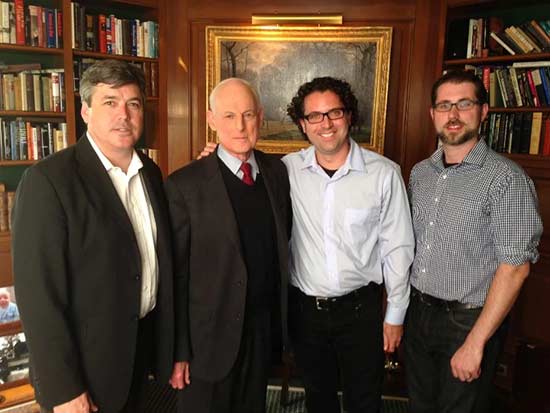"Games are all about taking risks."
- James Altucher
In 2013, we took a film crew to Greenwich, Connecticut.
At the time, the stock market and economy had "recovered" from the Panic of '08, and we were making a film about "risk!". We wanted to know how the bailouts and the Fed's quantitative easing program were impacting entrepreneurs' abilities to factor risk into their decision making.
It was kind of a heady subject, but our premise seemed relatively clear to me: if the Fed and Treasury were the "buyers of last resort" for mortgage securities and US Treasuries-and effectively bailing out Wall Street banks for a slew of bad decisions resulting from ignoring risk-wouldn't that just encourage banks to do it again?
The bailouts in our opinion at the time were taxpayer sponsored "free passes" on a slew of bad decisions.
We had already surmised quantitative easing (QE) and below market interest rates were going to create "moral hazard" in the economy at large; sending signals that everything was hunky-dory and money was free. We had also forecast it would lead to historic inflation, albeit about a decade too soon.
Either way, we wanted to know how bond traders and money lenders on Wall Street were pricing risk at the time.
We'd met Lewis Lehrman through our friend in Congress, Ron Paul. Dr. Paul and Mr. Lehrman were co-authors of the minority report of the 1982 U.S. Gold Commission, over which Rep. Paul presided. (The report was entitled The Case for Gold, which we also published at the time, through Laissez Faire Books.)
Lehrman had also been the managing director of Morgan Stanley and founder of his own investment firm L.E. Lehrman and Co. As such he seemed uniquely suited to help us understand how the massive 2008 bailouts and subsequent QE programs were affecting risk-assessment in the boardroom and on the trading floor, now that the markets had stabilized.
We met at Lehrman's home in Connecticut. A modest farmhouse-at least by Greenwich's standards-and horse stable. Surrounded by rolling hills and apple orchards, just north of the bustle of New York City, miles away from the nearest strip mall.


That was ten years ago. Much of the history of what QE and ZIRP will have wrought at the time has already been etched in history.
I was reminded of the conversation we had this morning because yesterday brought news Rite Aid declared bankruptcy yesterday.
The third largest pharmacy chain in the U.S. behind Walgreens and CVS cited lawsuits over selling opioids as the major reason for needing to restructure its debt. Second to opioids, same store theft and safety of their employees were mentioned as reasons to shutter as many 200 hundred stores.
The Rite Aid Corporation was an outgrowth of a family wholesale grocery business in central Pennsylvania, Louis Lehrman & Son, founded by Lew Lehrman's grandfather Louis and expanded by his father Benjamin. Lewis spent his teen years working in the family store. He later worked part-time and on holidays while paying his own way through Yale and later still, Harvard.
In 1962, the family biz, under his father's direction, began opening health and beauty stores. Finished with his studies, Lehrman joined the company full-time in 1964. The first Rite Aid pharmacy was opened in New York State later that year.
"Lehrman was forced to go from town to town," reported the New York Times, "looking for older stores in downtown areas where landlords were more desperate for tenants. Having found a site, he and his partners would devote a Saturday in painting and remodeling (usually spending less than $10,000) and a Sunday to stocking shelves. On Monday, the store would be open for business."
Rite Aid successfully IPO-ed in 1968. The cash infusion help with expansion. Until he stepped down as company president in 1977, Lehrman was the company's largest stockholder.
During our rather candid conversation, Lewis lamented the direction of the economy, the government, and the unimaginable growth in national debt.
None of it could have happened, we believe-the bailouts, quantitative easing, continued demise of the dollar-if the Bretton Woods exchange rate had not been dismantled in 1971.
Alas, Mr. Lehrman didn't want to talk much about his childhood working at the family store. And only waved his hand politely dismissing the question when we asked if he could expound on his years as Rite Aid president, overseeing its early expansion.
It's really too bad. By this point, we were just as intrigued in Rite Aid as an American success story as we were our main premise of measuring risk in the "new normal" post-bail out America.
At the time of its bankruptcy, yesterday, Rite Aid had grown to over 2,000 stores in 17 states with over 45,000 employees. The company had $24 billion in revenue in fiscal year 2023, filling 200 million prescriptions in the past year, but is still being gutted by crime and the opioid epidemic.
Walgreens and CVS have also shared their plan to close stores in risky neighborhoods, causing the New York Times to lament the creation of "Pharmacy Desserts" in many communities.
There's a lot to cover this week.
Rite Aid is but one of at least 517 high profile bankruptcies in 2023. At the current pace this year will outpace the number of bankruptcies in 2020 at the height of the pandemic lockdown. And clock in the second highest number since 2010's 827 business to close doors.
Corporate bankruptcies, the opioid crisis and random crime all figure highly in the forecast we've made for 2024 in The Great American Shell Game.
It's worth a listen,

Addison Wiggin
P.S. We're also digging into the expanding property and debt crisis in China, with new details of Country Garden's failure to meet $7.6 billion in payments through September.
Following on the heels of the bankruptcy of Evergrande, China's largest real estate developer, Country Gardens woes signify "deepening distress in China's housing market," writes Wiggin Session alum Peter Goodman in the New York Times, the very "intersection of finance, construction and household wealth."
Over the last 10 years, China's firms have invested more than a trillion dollars in huge infrastructure projects known as the "Belt and Road Initiative".
That spending is coming to an end.
"More than 150 countries have received Chinese money and technology to build roads, airports, seaports and bridges," Roland Rajah, of the Sydney based Indo-China Development Institute, told the BBC recently. "Chinese commitment to these projects may start to suffer if economic problems persist at home."
"Now Chinese firms and banks won't have the same financial largesse to splash around overseas," Rajah says. "Big exporters such as Australia, Brazil and several countries in Africa will be hit hardest by this." So will the United States, both as an exporter of goods and resources to China and as a consumer of "cheap stuff" made there.
The Chinese slowdown and internal debt-deflation issues, we expect, will have as resounding an impact on the global economy as the Great Depression did globally. We discuss the parallels of the two historic debt crises, here.
This article was originally published on The Wiggin Sessions.
About the Author
Addison Wiggin is an American writer, publisher, and filmmaker. He has been covering the financial markets, the economy and politics for three decades. An acclaimed New York Times best-selling author, his books include: The Demise of the Dollar, just released in its 3rd Edition covering the dollar from the "bailouts to the pandemic and beyond. Mr. Wiggin is also the co-author, with Bill Bonner, of the best-sellers Financial Reckoning Day, Empire of Debt. He wrote The Little Book of the Shrinking Dollar in the Wiley Little Book series. Addison is also the writer and executive producer of the documentary I.O.U.S.A., an exposé on the national debt, shortlisted for an Academy Award in 2008. He lives in Baltimore, Maryland with his family. Addison started his latest project, The Wiggin Sessions, powered by The Essential Investor, in March 2020. He films from a homegrown studio in his basement.



